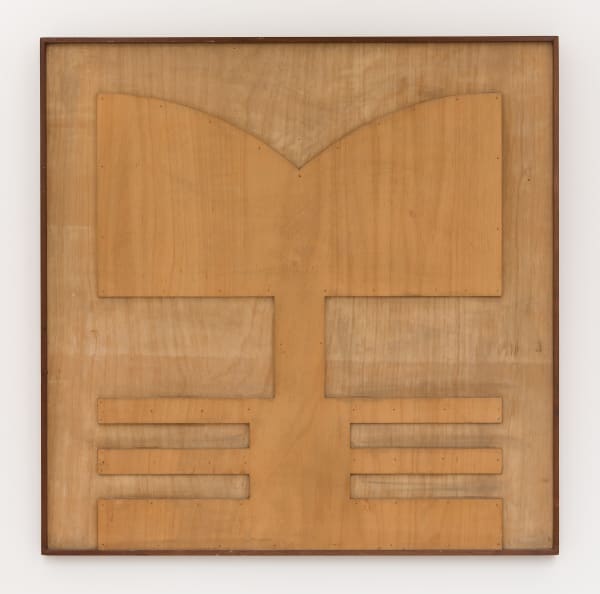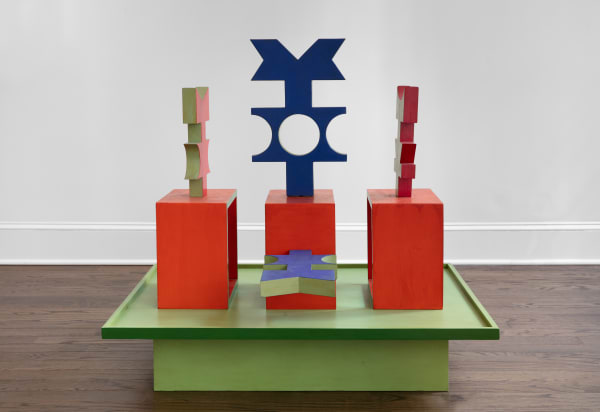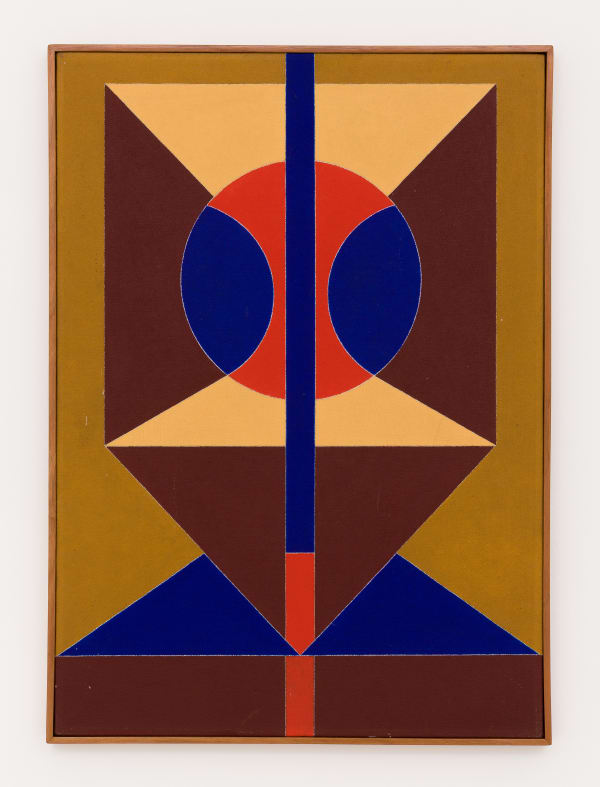Rubem Valentim Rubem Valentim
Past exhibition
Overview
Mendes Wood DM São Paulo is pleased to present the first solo exhibition of Rubem Valentim in the gallery.
Rubem Valentim began to produce work in the late 1940s. A self-taught painter. Valentim’s works unite various sources of Brazilian cultural heritage; referencing popular traditions from Northeastern ceramic production in Bahia to Southwest modernist proposals and the idea of cultural anthropophagy. In the case of Valentim, the formal development of constructivist ideas being recreated for the Brazilian standards in what concerns not only the formal artistic production but historical and political thought.
Valentim explored the Brazilian religious universe, these signs or emblems are originally geometric. In his work, it’s reorganized by an even more rigorous geometry, composed of horizontal and vertical lines, triangles, circles and cubes. In this way, the artist developed a personal repertoire that together with the notion of pictorial space and chromatic study, opens up to several possibilities. His chromatic study enables a language for the presented elements, a new signography, allowing their works to be revealed iconographically for those who have references of Afro-Brazilian religions and for those who do not. The semiology present in his work propose the union of the sacred and the Cartesian, he references spiritual questions almost mathematically.
The search for an artistic language exemplified by the Brazilian cultural miscegenation can also be reinforced by the fact that the artist is a Afro-Brazilian descent, seeking to portray in a pictorial way his cultural connections. The repetitive use of these elements is in the set of pure and vivid colors. For highlight chromatic intensity, white often appears as background. His work has an intrinsic meaning from the rite, the ceremony, also appropriate geometric abstract forms to compose his work.
Valentim lived in Rio de Janeiro between 1957 and 1963 where he became an assistant professor of Carlos Cavalcanti, teaching History of Art at the Institute of Fine Arts. He moved to Rome in 1963, with the prize to travel abroad, obtained in the National Salon of Modern Art - SNAM. In 1966 Valentim participated in the Global Festival of Black Arts in Dakar. Returning to Brazil, he moved to Brasilia and taught painting at the Arts Institute of the University of Brasília - UnB. In 1972, he made a marble mural for the government headquarters in Brasilia.
In 1979, Valentim sculpt a massive concrete sculpture, installed at the Praça da Sé, in São Paulo, defining it as the ‘Syncretic Framework’ of Afro-Brazilian Culture and, in the same year and is appointed, by a commission of critics, to execute five medallions of gold, silver and bronze, for which he recreated Afro-Brazilian symbols for an important public building. In 1998 the Museum of Modern Art of Bahia - MAM / BA inaugurates the Rubem Valentim Special Room in the Sculpture Park.
The work of Valentim makes the socio-political and historical factors that form the current popular understanding of Brazil tangible. The majority of which resound in the present day, as repercussions of the colonial process of the 16th century in Latin America and 19th century in Africa. Moreover, the works poignantly make reference to ever-present threat against a humanist progressive consciousness.
Rubem Valentim (*Salvador, 1922 – São Paulo, 1991).
Additionally, his work has been included in institutional group exhibitions such as Rubem Valentim, MASP, São Paulo, Brazil (2018); Construction and Faith, Caixa Cultural, São Paulo, Brazil (2018); Concrete Matters, Moderna Museet - Stockholm, Sweden (2018); The If Sand Were Stone: Contemporary Latin American Art From The Ago Collection, Art Gallery of Ontario, Ontario, Canada (2018); Axé Bahia: The Power of Art in an Afro-Brazilian Metropolis, Fowler Museum, Los Angeles (2017); Construction and Faith, Caixa Cultural, Brasília, Brazil (2017); Territories: Afro-descendant artists in the Pinacoteca Collection, Pinacoteca do Estado de São Paulo, Brazil (2015).
His works are in numerous permanent collections, such as: MoMA - NY, Museum of Modern Art of São Paulo, Pinacoteca do Estado de São Paulo, Museum of Modern Art of Rio de Janeiro, Museum of Modern Art of Bahia, Museum of Art of Brasília, MASP - São Paulo, Museum Afro Brasil, Patricia Phelps de Cisneros, Adolpho Leirner Collection, Gem Houston, among others.
The solo exhibition of Rubem Valentim at Mendes Wood DM is presented in collaboration with Instituto Rubem Valentim and Almeida e Dale Galeria de Arte.
Mendes Wood DM New York is pleased to present an exhibition of iconographic paintings, totems, reliefs, and tapestries by Rubem Valentim. Comprised of works made between 1969 and 1990, this exhibition brings together Valentim’s geometric abstractions which intertwine the modernist rationality of Constructivism with Brazilian popular culture.
Valentim’s works are structurally organized and composed of abstract signs made from horizontal and vertical lines, circles, cubes and arrows. These elements are geometric reductions of Orixá, or deities, from the Afro-Brazilian religions Candomblé and Umbanda. These religions were originally brought to the Americas by enslaved Yoruba peoples from West and Central Africa. Once in Brazil, Candomblé and Umbanda developed further from the presence of indigenous groups and the influence of the Roman Catholic Church installed in Brazil by Portuguese colonizers. Valentim specifically acknowledges this forced migrationin his totems, which draw from traditional African sculpture and Afro-Brazilian art. By integrating these two concepts Valentim created a new vocabulary that represented Brazil and recognized its origin in the African Diaspora.
Distanced from his Concrete contemporaries, form and meaning are intrinsically linked in Valentim’s works as his main concern was content rather than “optical games”. The use of blue for example suggests Portuguese tiles, a reference to the forced miscegenation of the Portuguese colonizer while at the same time making reference to Yemonja the Orixá of the sea. Similarly, the color white lends balanceand harmony to his compositions while also representing Oxala, the Orixá associated with the creation of the world, purity, and balance.
Through formal abstraction, Valentim recomposed the materiality of Afro-Brazilian art and the African Diaspora. He rejected the idea of the Afro-Brazilian as asubculture or product of cultural colonization as it was often depicted. His deepinterest lied in the “mystical impregnation, the awareness of the cultural values ofmy people,” and the search for a truly universal Brazilian language.
Valentim’s works are structurally organized and composed of abstract signs made from horizontal and vertical lines, circles, cubes and arrows. These elements are geometric reductions of Orixá, or deities, from the Afro-Brazilian religions Candomblé and Umbanda. These religions were originally brought to the Americas by enslaved Yoruba peoples from West and Central Africa. Once in Brazil, Candomblé and Umbanda developed further from the presence of indigenous groups and the influence of the Roman Catholic Church installed in Brazil by Portuguese colonizers. Valentim specifically acknowledges this forced migrationin his totems, which draw from traditional African sculpture and Afro-Brazilian art. By integrating these two concepts Valentim created a new vocabulary that represented Brazil and recognized its origin in the African Diaspora.
Distanced from his Concrete contemporaries, form and meaning are intrinsically linked in Valentim’s works as his main concern was content rather than “optical games”. The use of blue for example suggests Portuguese tiles, a reference to the forced miscegenation of the Portuguese colonizer while at the same time making reference to Yemonja the Orixá of the sea. Similarly, the color white lends balanceand harmony to his compositions while also representing Oxala, the Orixá associated with the creation of the world, purity, and balance.
Through formal abstraction, Valentim recomposed the materiality of Afro-Brazilian art and the African Diaspora. He rejected the idea of the Afro-Brazilian as asubculture or product of cultural colonization as it was often depicted. His deepinterest lied in the “mystical impregnation, the awareness of the cultural values ofmy people,” and the search for a truly universal Brazilian language.
Works
-
 Rubem Valentim, Emblema - 79 , 1979
Rubem Valentim, Emblema - 79 , 1979 -
 Rubem Valentim, Emblema - 79 , 1979
Rubem Valentim, Emblema - 79 , 1979 -
 Rubem Valentim, Untitled | Sem título, 1980s
Rubem Valentim, Untitled | Sem título, 1980s -
 Rubem Valentim, Emblema - Relevo - 85, 1985
Rubem Valentim, Emblema - Relevo - 85, 1985 -
 Rubem Valentim, Untitled
Rubem Valentim, Untitled -
 Rubem Valentim, Painel-Emblemático (Estudo - Protótipo) Escala 1/10, 1984
Rubem Valentim, Painel-Emblemático (Estudo - Protótipo) Escala 1/10, 1984 -
 Rubem Valentim, Emblema 79, 1979
Rubem Valentim, Emblema 79, 1979 -
 Rubem Valentim, Objeto Emblemático, 1969
Rubem Valentim, Objeto Emblemático, 1969 -
 Rubem Valentim, Emblema - 1980, 1980
Rubem Valentim, Emblema - 1980, 1980 -
 Rubem Valentim, Emblema Atipico, 1990
Rubem Valentim, Emblema Atipico, 1990
Installation Views












